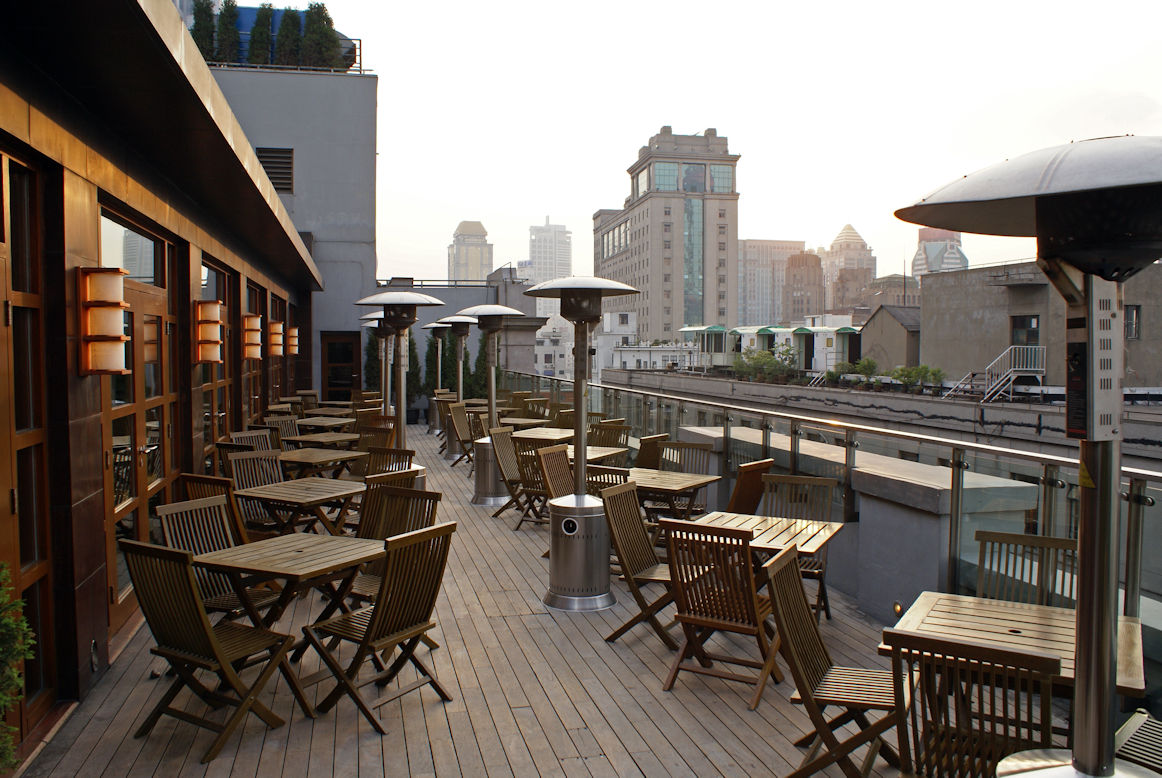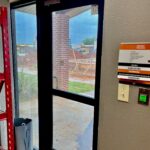 By now, I think most of you can recite by heart the locations where panic hardware is required by code (if not, here’s a Decoded article and a video). One of the locations where panic hardware is required by the IBC is on doors equipped with a lock or latch, serving an assembly occupancy with an occupant load of 50 people or more.
By now, I think most of you can recite by heart the locations where panic hardware is required by code (if not, here’s a Decoded article and a video). One of the locations where panic hardware is required by the IBC is on doors equipped with a lock or latch, serving an assembly occupancy with an occupant load of 50 people or more.
A change to the 2021 edition of the IBC addresses how to secure egress doors serving an exterior space like a roof terrace or enclosed courtyard, where the path of egress leads through the interior of the building. Prior editions of the code would not allow these doors to be locked, which created a conflict between egress and security. The 2021 change allows the doors to be secured on the exterior/egress side if certain criteria are met, and I wrote about this code change in this Decoded article.
The application described in the 2021 IBC allows a key-operated locking device, like a double-cylinder deadbolt, to be used to lock an exterior egress door leading into the building, and this locking method may be used on exterior spaces with an occupant load of 300 people or less – including assembly occupancies. So the question is this:
Does the 2021 IBC section addressing the locking of exterior spaces allow panic hardware to be omitted on doors serving exterior assembly spaces with an occupant load of 50 people or more?
The Quick Answer – as I understand it, the intent of this code change is that the key-operated lock would be installed as an alternative to the panic hardware (keep in mind – the AHJ always has the final say). If the roof terrace or enclosed courtyard is an assembly space, and the doors leading into the building are secured on the exterior/egress side using a method that meets the 2021 IBC, the key-operated lock is installed instead of panic hardware.
In Section 1010.2.9 – Panic and fire exit hardware, the 2021 IBC includes an exception stating: Exit access doors serving occupied exterior areas shall be permitted to be locked in accordance with Section 1010.2.4, Item 8. This is a reference to the section addressing exterior spaces, and it is an exception to the requirement for panic hardware on these doors. For this paragraph, the 2021 IBC Commentary states: Exception 3 applies to outdoor areas where occupants must egress from an exterior space through the building for means of egress. Section 1010.2.4, Item 8 has specific allowances and requirements for door locks for this application, which would allow a key-operated lock to be installed instead of panic hardware if all of the criteria are met.
Since this is a new code section, it’s best to check with the AHJ to confirm that their interpretation is consistent with mine, but it wouldn’t really be necessary to install panic hardware in addition to the double-cylinder deadbolt if the doors are not required to latch. Panic hardware is only required by code for doors equipped with a lock or latch, so doors with push/pull hardware would be code-compliant. When the space is occupied, the key-operated lock would be unlocked and the door would not latch. When the space is unoccupied and the door is locked with the key-operated lock, the door would not allow free egress even if it was equipped with panic hardware.
I could imagine an application where due to high wind (or in rare cases – a fire rating) the doors might need to be latched all the time. In that situation the doors should have panic hardware if serving an assembly occupancy, and the AHJ should be consulted about whether the double-cylinder deadbolt can be installed in addition to the panic hardware. Based on the 2021 IBC Commentary (above), I don’t think the intent of the code is to allow both panic hardware and a key-operated lock, but I don’t know that it negatively impacts the life safety of the building occupants to have both types of hardware on the door. Keep in mind that this change does not go into effect until the 2021 IBC is adopted in your project’s jurisdiction. In the meantime, the criteria listed in the 2021 edition could be used to request a code modification from the AHJ.
There is another exception in the panic hardware section that is sort of related and may set a precedent for the new section with regard to panic hardware: A main exit of a Group A occupancy shall be permitted to have locking devices in accordance with Section 1010.2.4, Item 3. This exception allows panic hardware to be omitted when a key-operated lock is used on the main entrance to a building classified as Group A (assembly), when all of the other criteria are met. The 2018 IBC Commentary confirms: This option is an alternative to the panic hardware required by Section 1010.1.10. There is a Decoded article about the requirements for main entrance doors with key-operated locks here, and an update here. The other two exceptions in the panic hardware section address the use of electrified hardware on doors with panic hardware.
Any questions?
You need to login or register to bookmark/favorite this content.





An increasing number of local jurisdictions in Southern California are requiring exit devices on exterior pool gates. They are interpreting the pool area to be an assembly space of potentially over 50 people. This creates all sorts of security challenges, as it is not difficult to operate a push bar from the outside on most gates by reaching through, over, under, or with a rope/wire thrown over the top. Mitigating this is keeping our welders busy! Any thoughts?
That has been my experience too…many doors and gates serving swimming pools require panic hardware. And I understand the security challenges. I wrote an article recently about the code requirements that apply to these openings (https://idighardware.com/2021/04/decoded-door-gate-hardware-for-swimming-pools/), but I don’t have a good recommendation for keeping people out, other than changing the design of the gate.
– Lori
“””A main exit of a Group A occupancy shall be permitted to have locking devices in accordance with Section 1010.2.4, Item 3″”””””
So can a building/ business have more than ONE MAIN EXIT???
Hi Charles –
In this section the IBC says the key-operated lock can be used on the main entrance door or doors. That leaves it up to you (the AHJ) to decide which door(s) qualify.
– Lori
Sorry this is so long but… This exception may address one of the big security issues I’ve had to deal with over the years, but I think there are still issues…
The concern is egress from school courtyards.
Courtyards are often viewed by AHJs as gathering spaces and as such exit devices, lighted exit signs and FA pull stations/strobes are required on the exterior side of the opening allowing re-entry in to the building as the path of egress.
As such, the most effective way I’ve been able to overcome security issues is with a mag lock connected to a wall mounted key operated switch. Entry into the courtyard would only be possible if you had a key to deactivate the mag. Since two or more paths of egress are required, the mags would all be connected so if one is unlocked, they all are unlocked. The one weakness in this approach is that the mags are required to be connected to the FA; so if someone were able to gain access to the courtyard (ladder on exterior and going across the roof and dropping down), they could essentially pull the FA and gain entry. The upside to that scenario is that the authorities are going to be arriving soon.
Do you see the double key deadbolt as being a viable option? I don’t think it would be because who’s to say the other paths of egress would be unlocked allowing reentry?
Hi Darrell –
Going by the language of the 2021 code, the double-cylinder deadbolt would be acceptable if all of the other criteria are met. Note that the requirements would include a weatherproof phone or two-way communication system in the courtyard.
– Lori
I hear what you’re saying, but the more I think about this the mag locks is still the safer way to go in my eyes.
If the second means of egress is needed and it’s locked down, the outdoor phone just becomes a way for you call for help, doesn’t get you out of the hazard.
Hi Darrell –
I wasn’t saying that what the code allows is safer – there are advantage to the mag-locks. I was just describing what the 2021 IBC allows.
– Lori
Hi All
I think there are some serious risks in allowing a double cylinder lock on an egress door without a rigorous protocol for locking the door.
Suppose the deck is used as a restaurant and and an untrained person starts using the double cylinder lock for crowd control during a big party on the deck? And of course there are many other scenarios that can be imagined.
Hi George –
I don’t disagree with you, but the new section is similar to the code language that addresses double-cylinder deadbolts on the main entrance of a building. There isn’t a requirement for training/policies in either section. At least the new section requires a way of communicating from the exterior space.
– Lori